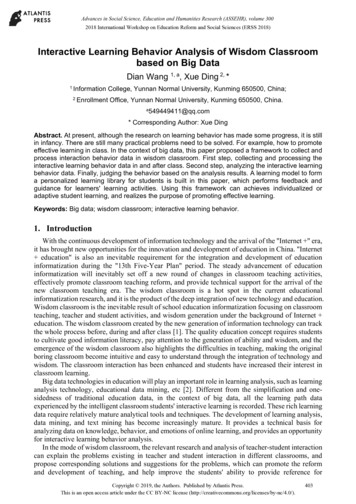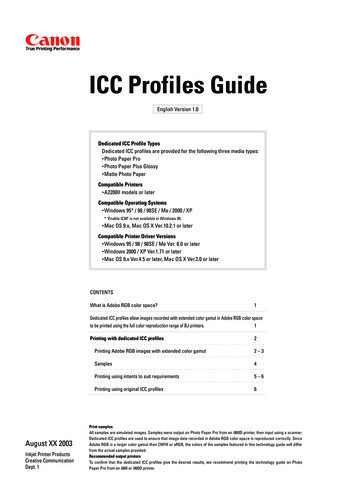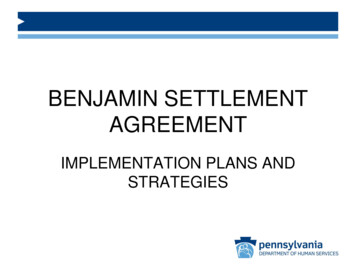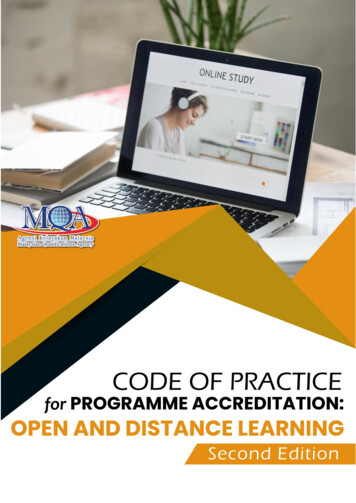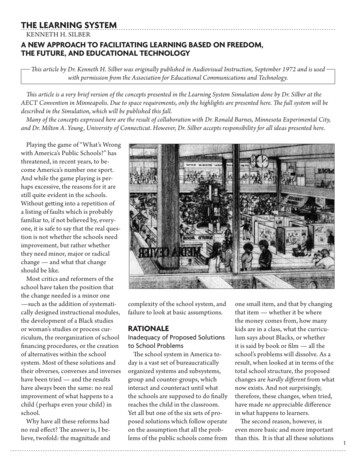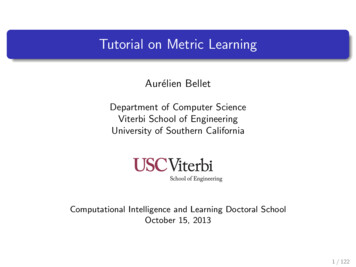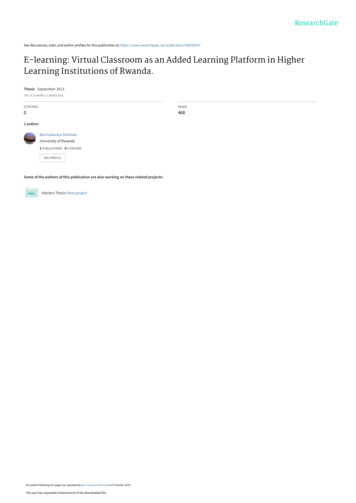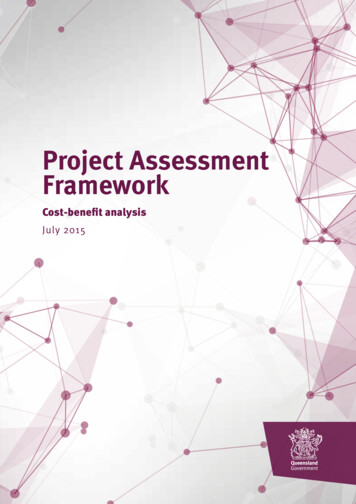
Transcription
Analysis of selected e-learningplatforms and creation of guidelinesBased on Aula Virtual (Blackboard), Wikamp (Moodle) and Federica.eu (proprietaryMOOC platform)
List of tables . 3List of figures . 31Introduction . 42Descriptions . 532.1Federica . 52.2Aula Virtual. 62.3WIKAMP . 8Instructional Design . 103.1The design of courses on Federica . 103.2Course design in AulaVirtual . 113.3Course design in WIKAMP. 121.1.1Course types . 121.1.2Videos . 121.1.3Webinar availability and automation . 123.44567Comparison of the platforms . 14Workflow Management. 154.1Federica . 154.2Aula Virtual. 154.3WIKAMP . 16Course Versioning & Editing . 165.1Federica . 175.2Aula Virtual. 175.3WIKAMP . 17Registration and access . 196.1Federica . 196.2AulaVirtual . 196.3Wikamp Federated login . 20Conclusions . 21
List of tablesTable 1 Platform comparison . 14Table 2 Comparison of several important considerations . 18List of figuresFigure 1. Federica Weblearning Landing page . 5Figure 2 A Course landing page, accessible without registration. 6Figure 3 Official website of Blackboard . 7Figure 4 General overview of the platform . 7Figure 5 Specific view of one of the courses . 8Figure 6 Wikamp landing page . 9Figure 7 Wikamp information portal. 10Figure 8 Wikamp helpdesk . 12Figure 9 Webinar booking system. 12Figure 10 Webinar confirmation with details . 13Figure 11 Quick view of the Teacher dashboard, clicking in the “preliminary studentview” option . 16Figure 12 registration form . 19Figure 13 Wikamp login . 20Figure 14 Wikamp platforms. 20Figure 15 Integration with Office 365 . 21
1 IntroductionThe main objective of this IO is the analysis of the selected e-learning platforms, wherethe courses will be uploaded, in order to facilitate guidelines for connection and thecreation of a user guide for universities indicating how to upload the courses. This analysiswill consist of a study of usage, supported evaluation methods, teaching methodology,etc. The e-learning platforms selected by the partners are the ones used in the respectiveuniversities and their input has been provided in order to analyse the platform. Theseplatforms are Blackboard-based Aula Virtual from the University of Alcalá, Moodle-basedWikamp from the Lodz University of Technology and a proprietary Massive Online OpenCourse (MOOC) platform Federica Weblearning - Federica.eu. The main objective of thisaction is, therefore, to analyse the features and applicability of the specific e-learningplatforms which will be operating in ErasmusX.This study will facilitate the creation of guidelines for universities on how to upload theonline courses in the common platform, as detailed in IO1, and will allow eachparticipating university to develop their own user guide for teachers willing to learn howto create new online courses.
2 Descriptions2.1FedericaUniversity of Napoli Federico II established a web learning center in 2006.It is accessible at https://federica.eu/ (for English version https://federica.eu/?lang en).Figure 1. Federica Weblearning Landing page
Figure 2 A Course landing page, accessible without registrationThe web-learning center is named "Federica Web-learning" and is the Centre forMultimedia Distance Learning of the University of Naples Federico II. It is the largestworldwide provider of open access multimedia courses in Italian. Federica Weblearninghas developed an infrastructure for free access to the knowledge fully devoted toinnovation and experimentation of multimedia distance education, with intenseinternational attitude. "Federica Web-learning" success is confirmed by the numbersreached in the first seven years on the platform www.federica.unina.it: 300 blendedcourses, 5.000 lessons, an increasing trend of more than 5 million of accesses per yearfrom 2016 onwards. Today Federica is the largest single university platform in Europe,with 120 MOOCs published on the Federica.eu portal since 2015, which cover a widerange of academic disciplines. With Federica Weblearning, the University Federico II hasled EMMA (European Multiple MOOC Aggregator), a project funded by the 7thFramework Programme with a network of 12 universities, research centers andcompanies from 8 European countries operating in the digital education.2.2Aula VirtualUniversity of Alcalá (UAH) has been using AulaVirtual for almost 10 years. AulaVirtualstands for “Virtual Classroom” in Spanish and it is an implementation of online courseplatform based primarily in Blackboard: https://blackboard.com
Figure 3 Official website of BlackboardFigure 4 General overview of the platform
Figure 5 Specific view of one of the coursesIt could be said that Blackboard is particularly popular in North America, while Moodle ismostly leveraged in Europe. In fact, most universities in Spain use Moodle instead ofBlackboard, so UAH is an exception.Courses in AulaVirtual are only offered to students enrolled in the University, eitherstandard or Erasmus students. All courses have one dedicated space in AulaVirtual to hostonline content. Though most of them are only created to support the physical classrooms,UAH also offers exclusively online courses, mainly for master degrees and specializationcourses.Quick references:1. General manual of Blackboard: Manual Web de Blackboard (Spanish)2. Specific manual of AulaVirtual, as an implementation of Blackboard in UAH: Ayuda deprofesores de la UAH (videotutorial and other resources in Spanish)3. Official Blackboard guide: Ayuda oficial Blackboard para el profesor (any language, althoughthe most complete version is in English).2.3WIKAMPWIKAMP platform is based on open-source Moodle LMS (Learning Management System).It is different from Open edX for example, but Moodle may be found in numerous places.For this reason, there is both official documentation on moodle.org website and materialson-line like YouTube videos regarding specific aspects of course organization.There are official training courses for TUL teachers, certified by TUL E-Learning Centre.Such certificates are valid only for specific amount of time, and require recertification
after for example two or three years. After being certified teachers gain administrativeaccess to their courses and have full control over their contents.WIKAMP is the e-learning platform of Lodz University of Technology, Poland (TUL). Thename stands for “Virtual Campus” in Polish. WIKAMP is based on open-source Moodle,with additional plugins and customizations. Starting address of the platform is:https://edu.p.lodz.pl?lang enFigure 6 Wikamp landing pageWIKAMP started over 10 years ago at Faculty of Technical Physics, Applied Mathematicsand Computer Science, then expanded to university-wide service. Nowadays it has over18,000 users: teachers and students from Poland, Europe (Erasmus), also India, China,etc. Over 600 teachers are trained to use this platform (and this number is growing).Platform is also used for university-wide information portal, with important documents(e.g. internal rules of law), searchable forums with notifications for all employees andstudents, as well as internally developed plugins for administrative purposes.This can be found at: https://adm.edu.p.lodz.pl?lang en
Figure 7 Wikamp information portal3 Instructional Design3.1The design of courses on FedericaFederica.EU, differently from other LMS (Learning Management Systems), such asMoodle or Open edX, is a proprietary platform that is not supposed to be usedwithout a technical help and supervision. For this reason, no technicaldocumentation is available.The Teacher is guided through the process of organizing and producing the lecturesby two course managers that help with both the technical production process, andthe lectures planning process. The help is provided on every aspect of the course:video production conducted either in the internal video recording room or inexternal; adding slides to the lectures; quiz and tests productions.The joint action of Teacher and online course producer experts guarantees a very highquality of t ew registrationsPossible. linked to the University profile.Erasmus students that come to Lodz, Poland aresupported by Students Office. Such students gettheir student IDs, passwords, and are grantedregular access to our electronic systems like allTUL students.Quality AssuranceQuality assurance managed bythe continuous quality checks atall stages of course productionThis is managed by the central managers and, particularly by theteaching section / faculty directives. They have a possibility to dorandom checks and professors are aware of it, but that's it.I'd say this is not something that depends on the platform itself,but on the University directivesAbility to link with or developdatabase-driven InteractivewebsitesStandard (SCORM/AICCS)To some extent, case by casebasisTests can be generated in a random way based on a database, butthat's it.Team from E-Learning Centre (CEL) reviews anycourses that are to be publicly visible.Otherwise teachers that are creators/editors incourses are responsible for course content.Teachers that use WIKAMP are first certified, andhave support from CEL for technical questionsregarding courses and activities. There is areview process, but not on a regular basis for allcourses that are on WIKAMP platforms.case-by-case basis, due to time and effortconsiderationsSCORM, xAPISCORM (up to 4th Edition), xAPI, IMS, NLN contentSCORM, xAPI, IMLS, AICC
6 Registration and access6.1FedericaThe registration procedure requires to provide quite basic information and sends aregistration link to the provided address (beware the spam folder).A screenshot of the registration page is given below.Figure 12 registration formEnrolling is straightforward and does not require an activation email.6.2AulaVirtualStudents cannot register to AulaVirtual by themselves. Accounts are created by a specificAulaVirtual unit in UAH and are only provided after enrolment. In this way, accounts arecontrolled and unique per student (as per professor). These accounts are global andcommon for any other tool from UAH (for example, University email or MiPortal, aplatform that provides a general overview of the student progress, including paid fees or
passed courses). In fact, accounts are linked and integrated with a global Outlook365profile from Microsoft.In the case of enrolment, this is done automatically after the enrolment is done. Studentsare assigned to the enrolled courses and if the course coordinator creates a “space” inAulaVirtual for that course, then it will automatically appear to all students enrolled inthe course. Additionally, the Teacher profile can also enrol and remove students to theirowned courses.The process is the same in the case of Erasmus students. Once the Learning Agreementis approved, the Erasmus coordinator sends it to the AulaVirtual unit, and they create aunique account for these students and enrol them in the requested courses.6.3Wikamp Federated loginTo access WIKAMP, a user selects access type (left). One may login as regular user,student or professor, or use guest access with limited possibilities. In the latter case useris prompted for credentials using CAS / Central Authorization Service (right).Figure 13 Wikamp loginAfter logging in, users may switch from home portal to others and come back to homeportal, using “WIKAMP Platforms” menu:Figure 14 Wikamp platforms
Since September 2019 students and employees of TUL after single-sign-on process nowhave access to Office 365 applications including: Outlook, Calendar, Word, Excel,PowerPoint, Teams, OneDrive, etc.Further integration of Moodle / WIKAMP with Office 365 is currently undergoing.Figure 15 Integration with Office 3657 ConclusionsOverall, we have three different platforms, used for different purposes: self-directedMassive Online Open Courses, fully aligned with curriculum (Federica), Complementaryto curriculum (Aula Virtual) and Blended Learning, supervised learning (WIKAMP). At thesame time, these platforms are also different when it comes to their features andcapabilities (analysed in the chapter 3.4). For this, it is advisable to use each platform inthe consortium according to their affordances and instructional models.
EN This project has been funded with support from the European Commission. This publication[communication] reflects the views only of the author, and the Commission cannot be heldresponsible for any use which may be made of the information contained therein.ES El presente proyecto ha sido financiado con el apoyo de la Comisión Europea. Esta publicación(comunicación) es responsabilidad exclusiva de su autor. Ni la Comisión, ni el Servicio Español parala internacionalización de la Educación (SEPIE), son responsables del uso que pueda hacerse de lainformación aquí difundida.
etc. The e-learning platforms selected by the partners are the ones used in the respective universities and their input has been provided in order to analyse the platform. These platforms are Blackboard-based Aula Virtual from the University of Alcalá, Moodle-based Wikamp from the Lodz University of Technology and a proprietary Massive Online Open

